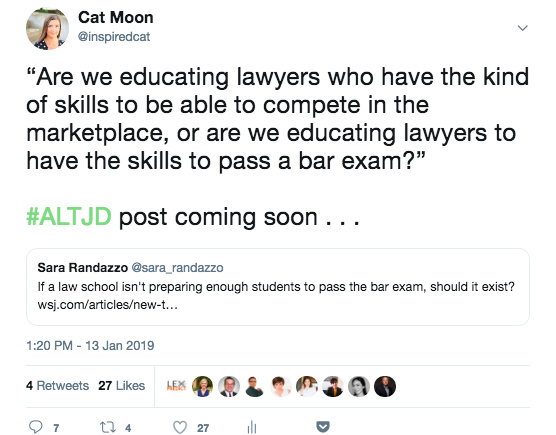By guest blogger Alyson Carrel.
Technology is a major driver to innovation in the law and legal services. Although it isn’t the only driver of change, advancing technology has demonstrated a crucial need to reconsider how and what we teach in law schools. In describing this need, articles talk about teaching at the intersection of law & technology, but what does that mean? This overarching phrase, teaching at the intersection of law & technology, implies many different things; here are just five of the different meanings implied:
The law of technology: How is traditional doctrine applied to advances in technology and how might the law need to change in order to adapt to or shape the future stemming from technological changes?
The technology of law: How is technology changing the delivery of legal services and what ethical responsibilities does this impact?
Innovation: How is innovation, often, but not always driven by advancing technology, changing client expectations?
Tech fluency: What technological skills do law students need in order to successfully enter the changing legal service delivery environment?
Instructional Technology: How can educators utilize technology to better engage students and enhance student learning?
I find that the use of this overarching phrase creates confusion and unnecessary challenges to our many efforts of redesigning and modernizing legal education. Although we need colleagues to understand the multiplicity of issues facing the future of law and legal education — and there are many — we need to be more precise in what changes we seek in order to more effectively engage our audience.
Each faculty member wears a lens through which they perceive legal education reform. Some focus on pedagogy, some on doctrine. Unfortunately, the many meanings of the phrase intersection of law & technology may lose meaning if they perceive it through the wrong lens.
For instance, a doctrinal faculty member who views legal education through a research lens, may dismiss a workshop discussing the impact of technology on a substantive area of the law because the event was billed as a talk on the intersection of law & technology, which the faculty assumed meant the use of technology as a legal operations tool.
Or a faculty member who teaches skills courses or clinics and views legal education through an experiential lens might miss a session on how to use technology to enhance lawyer’s skills in providing client services because they assumed the session was about instructional technology.
The phrase intersection of law & technology is not inherently problematic, it is in fact a great phrase to mean all things related to law and technology. But when we are trying to persuade skeptical colleagues to heed our warning that legal education must adapt to the changing marketplace, we must communicate with more specificity so that they can hear us through whatever lens they wear.


